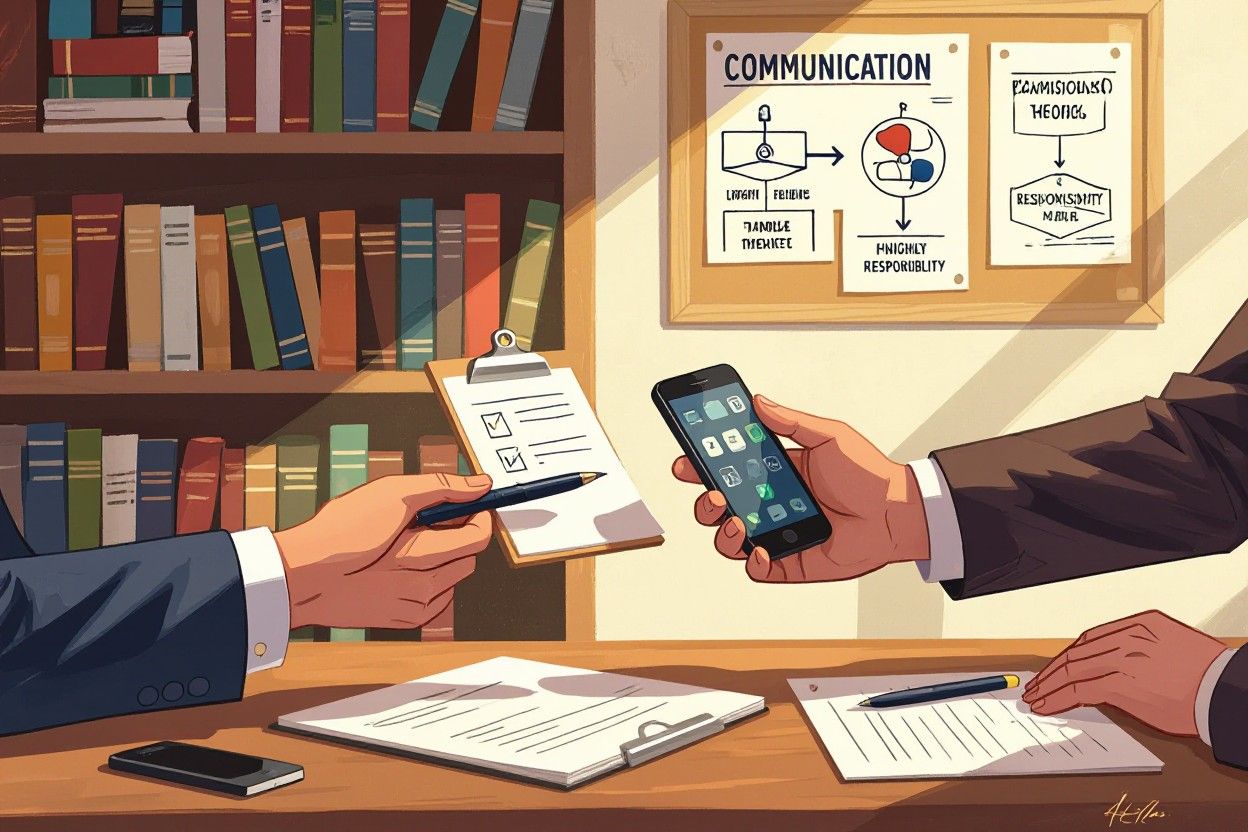The Significance of Taking Responsibility for Your Part In Communication Dynamics
Over time, you have likely experienced misunderstandings that stem from communication breakdowns. Understanding the significance of taking responsibility for your part in communication dynamics empowers you to foster clearer interactions and build stronger relationships. By acknowledging your role, you enhance your ability to listen actively, express yourself clearly, and address conflicts constructively. This awareness not only improves mutual understanding but also encourages a collaborative environment where all parties feel valued and respected. Embracing this responsibility transforms the way you connect with others, promoting trust and effective dialogue in both personal and professional settings.
The Psychological Framework of Responsibility in Communication
The Role of Self-Perception
Your self-perception acts as the internal lens through which you interpret interactions and assign meaning to communication events. If you view yourself as a passive participant or someone who lacks influence in conversations, you may unconsciously relinquish your role in shaping the exchange, leading to less ownership over misunderstandings or conflicts. Conversely, when you perceive yourself as an active contributor, you become more attuned to your verbal and nonverbal cues, recognizing the power you have to affect outcomes. Research in social psychology indicates that individuals with a strong sense of agency are more likely to engage in perspective-taking and adapt their communication style to foster mutual understanding.
Moreover, how you assess your responsibilities within conversations impacts your behavioral responses. For example, someone who views themselves as responsible for collaborative dialogue tends to approach disagreements not as battles to win, but as opportunities to explore underlying concerns, facilitating resolution. Your self-perception also influences whether you attribute failures to external circumstances or to your communicative choices — this attribution style shapes your motivation to improve interaction skills and handle future conversations with greater intentionality.
How Responsibility Influences Emotional Intelligence
Emotional intelligence is deeply intertwined with your willingness to accept responsibility in communication. Recognizing your part in how exchanges unfold enables you to better identify your emotions and those of others, enhancing empathy and social awareness. Studies show that individuals who embrace responsibility display higher levels of emotional regulation because they acknowledge their influence over emotional climates rather than attributing reactions solely to others. This insight allows you to manage conflicts with greater composure and avoid escalation driven by attributing blame externally.
Expanding on this, taking responsibility in communication encourages you to reflect on feedback and emotional cues, strengthening your ability to respond adaptively rather than react impulsively. You become more adept at navigating complex interpersonal dynamics, as your sense of accountability cultivates openness to vulnerability and promotes trust-building behaviors.
Ultimately, by integrating responsibility with emotional intelligence, you develop a communication style grounded in self-awareness and mutual respect. This fusion equips you to decode nuanced emotional signals, approach dialogues with flexibility, and maintain constructive interactions even amid disagreement, positioning you as a more effective and empathetic communicator.

The Ripple Effect: Understanding Communication Dynamics
The Interconnected Nature of Conversations
Your words and actions in a single conversation rarely exist in isolation. Each exchange influences the next, creating a cascade of responses that shape relationships over time. For instance, a brief misunderstanding during a team meeting can alter the tone of subsequent interactions, potentially impacting collaborative success. Recognizing how your contributions connect to the larger thread of dialogue helps you see communication as an ongoing process rather than a series of independent events.
In practice, this means paying close attention to how your statements align with others’ perspectives and how they might trigger certain reactions. Studies in social psychology highlight that even subtle changes in tone or phrasing can sway group sentiment, affecting engagement levels. By tuning into these interconnected patterns, you enhance your ability to navigate conversations with greater empathy and effectiveness.
The Impact of Personal Accountability on Group Dynamics
Your willingness to own your role within a conversation significantly shifts how groups function. When you accept responsibility for your words and behaviors, it diminishes blame and defensiveness, paving the way for more constructive dialogue. For example, teams where members admit mistakes openly tend to resolve conflicts faster and maintain higher trust levels, as demonstrated by research from organizational behavior experts.
Accountability also encourages others to reflect on their own communication styles, promoting a culture of transparency. As you model this behavior, the group collectively strengthens its resilience, enabling smoother navigation through challenges and disagreements. Ultimately, your personal commitment to responsible communication acts as a catalyst for healthier relationships and improved outcomes within the group setting.
Expanding on this further, when individuals take responsibility, they contribute to establishing psychological safety — a state where people feel comfortable expressing viewpoints without fear of judgment. This environment boosts creativity and problem-solving, as team members are more likely to share innovative ideas and voice concerns. In contrast, teams lacking accountability often experience stagnation due to suppressed communication and unresolved tensions, illustrating the direct correlation between your personal approach and the overall health of group dynamics.

Shifting the Blame: A Breakdown of Defensive Communication
Common Defensive Mechanisms
When you find yourself on the defensive during a conversation, you may unconsciously resort to tactics like denial, deflection, or counterattacking. Denial involves rejecting any suggestion of fault or error, effectively closing off the opportunity for genuine dialogue. Deflection shifts attention away from your own role by pointing out the other person's mistakes or shortcomings, which disrupts mutual understanding and escalates conflict. Counterattacking, on the other hand, directly responds to criticism with criticism of your own, turning communication into a contest rather than a collaboration.
These mechanisms often serve as protective shields against feelings of vulnerability, but they also erect barriers that prevent resolution. For example, in workplace settings, employees who habitually deflect their part in miscommunications can create an environment of distrust and blame. Research from the Journal of Applied Psychology found that teams with high incidences of defensive communication experienced 30% less effective collaboration, underscoring the tangible impact these defense patterns have on outcomes.
The Cost of Refusal to Own Responsibility
Rejecting responsibility in conversations can lead to a cascade of negative effects, from eroding trust to stalling problem-solving. As you repeatedly avoid accountability, relationships begin to suffer because the other party perceives your unwillingness as disregard for their feelings or perspectives. This can foster resentment and reduce openness, making it progressively harder to engage in honest dialogue. Over time, communication breaks down to superficial exchanges, losing depth and meaning.
Beyond personal relationships, the cost extends to professional environments where blame-shifting diminishes team morale and efficiency. Studies indicate teams that engage in mutual accountability outperform those mired in defensiveness by 25% in meeting project deadlines and achieving goals. On an individual level, refusing to take responsibility impedes your personal growth by limiting self-awareness and the ability to learn from mistakes, creating a cycle that maintains ineffective communication patterns.
Additionally, the persistence of defensive communication can have psychological costs. Continually denying your role in conflicts often leads to increased stress and anxiety, as unresolved issues linger beneath the surface. Over time, this tension not only diminishes your emotional wellbeing but also impacts physical health, contributing to chronic fatigue and weakened immune response. Understanding these ramifications emphasizes that embracing responsibility is not just beneficial for your relationships but important for your holistic health and development.
Empowering Relationships through Constructive Feedback
Techniques for Delivering and Receiving Feedback
Mastering the art of constructive feedback involves balancing honesty with empathy. When delivering feedback, frame your observations using specific examples rather than generalities; this approach minimizes defensiveness and anchors the conversation in observable behavior. For instance, saying, “During yesterday’s meeting, I noticed you interrupted several team members, which affected the flow of ideas,” is far more effective than a vague, “You are disruptive.” Pair this clarity with “I” statements to own your perspective, such as “I felt that some voices weren’t heard,” which helps prevent the other person from feeling attacked.
Equally important is how you receive feedback. Active listening plays a key role here—summarize what you've heard to ensure understanding and refrain from responding while the other person is speaking. These steps can reduce misunderstandings and demonstrate your openness to growth. Research from the Harvard Business Review indicates that employees who actively engage with feedback initiatives improve performance ratings by up to 14% and report increased job satisfaction, underscoring the tangible benefits of receptive attitudes.
The Importance of Openness in Fostering Trust
Openness serves as the foundation for trust in all communicative relationships. Sharing your thoughts, concerns, and even vulnerabilities invites reciprocity, creating a safe space for honest exchange. Consider how a manager who openly discusses challenges with their team sparks collaboration rather than fear, encouraging creative problem-solving rather than concealment. In contrast, withholding information breeds suspicion and fractures the connection that smooth collaboration depends upon.
Visible transparency about your intentions and decisions also solidifies reliability. When colleagues or loved ones understand your reasoning—even if they don’t always agree—it mitigates feelings of uncertainty. Studies show that teams with high transparency levels are 25% more likely to exceed performance goals, signaling how openness not only nurtures trust but also drives success.
Delving deeper, openness does not imply sharing everything indiscriminately but rather choosing authenticity over facades. This discernment helps you maintain boundaries while signaling respect for others. In practice, this means admitting mistakes promptly, asking for input when unsure, and clarifying expectations to prevent miscommunication. Such behaviors gradually condition your relationships to embrace transparency as a norm, reducing conflict and reinforcing mutual respect over time.

Identifying Your Communication Style: A Self-Assessment
Tools for Analyzing Your Patterns
You can start by reflecting on recent conversations where communication felt smooth or broke down. Tracking these instances helps reveal recurring habits, such as interrupting others or relying heavily on written over verbal communication. Use journaling to record your thoughts and feelings during interactions; patterns often emerge in emotional responses linked to specific styles like passive, aggressive, or assertive communication.
Several standardized assessments offer structured insights into your communication preferences. Instruments like the DISC personality profile or the Social Styles Model categorize tendencies into actionable profiles, helping you understand whether you lead with logic, empathy, or control. Combining these tools with feedback from trusted colleagues or friends provides a richer picture of how your style lands in different settings.
Adjusting Your Style for Greater Responsiveness
Shifting your approach involves more than simply mimicking others; it requires tuning in to the signals your conversation partner sends and adapting accordingly. For instance, if you notice someone prefers direct, concise information, dialing back on emotional appeals can enhance clarity. Conversely, when dealing with more relationally oriented individuals, emphasizing empathy and active listening creates stronger rapport and openness.
Incremental adjustments—such as pausing longer to invite input or rephrasing statements to confirm understanding—can foster responsiveness without sacrificing authenticity. Analyzing feedback loops in ongoing dialogues helps you calibrate tone, pacing, and content dynamically, leading to interactions that feel balanced rather than one-sided.
Taking a flexible approach to your communication style also means recognizing the context and shifting demands of different conversations. In high-stakes negotiations, for example, a more assertive and structured style may yield results, while brainstorming sessions often benefit from a collaborative and exploratory tone. By continuously assessing both your style and your audience’s reactions, you create space for meaningful exchanges where every participant feels heard and respected.
Practical Tips for Taking Responsibility in Daily Interactions
Simple Strategies for Mindful Communication
Adopting mindfulness in communication begins with the habit of active listening. By focusing fully on the speaker without planning your response ahead, you gain deeper insight into their perspective and reduce misinterpretations. For example, during a team meeting, instead of immediately countering a point, pause to reflect on the speaker’s intent and emotions. This technique has been shown to improve empathy, which Harvard research links to stronger interpersonal relationships and less conflict.
Another key strategy involves owning your emotions and expressions, rather than attributing them solely to external triggers. Notice how you phrase statements: “I feel concerned about the deadline” instead of “You are stressing me out with your delay.” Such language frames your experience as personal, fostering a non-confrontational environment. Thou shalt cultivate this self-awareness to transform conversations from arguments into collaborative problem-solving.
Building Accountability into Team Environments
Teams that embed accountability into their culture experience heightened trust and clearer communication pathways. Regular check-ins, where each member briefly reports on their commitments and obstacles, promote transparency. For instance, Google’s re:Work initiative highlights that structured peer feedback boosts both individual and collective performance by creating safe spaces to acknowledge missteps and celebrate progress.
Implementing shared agreements at the outset of projects—detailing responsibilities, deadlines, and communication norms—also anchors responsibility firmly within the group. When roles and expectations are clear, members are more likely to self-correct and support each other in maintaining group objectives. This approach reduces finger-pointing and fosters a culture where accountability is seen as a collective asset.
Furthermore, leadership modeling accountability solidifies this ethos. Leaders who openly admit mistakes and demonstrate corrective action set powerful examples. This practice, according to workplace psychology studies, encourages team members to do the same, resulting in an environment where responsibility is a shared, dynamic process rather than a burden borne by individuals alone.
Leadership and Responsibility: Cultivating a Culture of Accountability
The Leader’s Role in Modeling Responsible Communication
As a leader, your behavior sets the tone for the entire communication culture within your organization. Demonstrating transparency and owning up to mistakes openly encourages your team to do the same. For instance, acknowledging missteps during a project review signals that accountability isn't about assigning blame but about learning and improvement. This can promote a psychologically safe environment where team members feel comfortable sharing honest feedback and admitting to their own communication shortcomings.
Beyond admitting errors, your language choices and active listening play a powerful role. When you consistently use inclusive language and validate diverse perspectives, you create a space where responsibility is shared rather than shifted. Leaders who respond thoughtfully rather than defensively during conflicts exemplify how constructive communication works in practice. These behaviors help dismantle defensive barriers and foster a collaborative culture where accountability drives progress.
Encouraging Responsibility as a Core Organizational Value
Embedding responsibility for communication as a foundational value requires intentional reinforcement across all levels of the organization. You can start by incorporating clear expectations around communication responsibility into performance evaluations and team charters. Training programs focused on interpersonal skills and conflict resolution further solidify this commitment, equipping employees with tools to engage constructively and own their communication roles fully.
Moreover, recognizing and rewarding individuals or teams who exemplify accountable communication promotes a culture where these behaviors are aspirational and celebrated. Regular feedback loops and open forums allow ongoing dialogue about communication challenges and successes, reinforcing responsibility as a shared endeavor. Embedding these practices leads to measurable improvements; organizations with strong accountability cultures report up to 21% higher productivity and 30% better employee engagement compared to those without.

The Long-Term Benefits of Embracing Responsibility in Communication
Enhanced Relationships and Collaboration
Taking ownership of your role in communication creates a foundation of trust that others notice and appreciate. When you acknowledge your contributions to misunderstandings or conflicts rather than deflecting blame, you foster an environment where open and honest dialogue becomes the norm. This transparency encourages colleagues and loved ones to let down their defenses, paving the way for deeper connections and more productive partnerships. You may find that meetings or discussions which previously felt tense or unproductive start flowing more naturally, with everyone more willing to share ideas and concerns.
Collaboration benefits substantially as a result. Teams with members who accept responsibility often experience fewer communication breakdowns, reducing project delays. For instance, a study by the Project Management Institute revealed that organizations encouraging accountability in communication saw a 20% increase in on-time project delivery. By actively engaging in your part of communication dynamics, you help create a culture where problem-solving takes precedence over finger-pointing, improving efficiency and morale across your professional and personal networks.
The Positive Impact on Personal and Professional Growth
Owning your communication role sharpens your self-awareness, allowing you to identify patterns that might have hindered progress or relationships. This insight provides the groundwork for targeted improvements, whether in how you express ideas or receive feedback. Through consistent practice, you become better equipped to navigate complex situations diplomatically, enhancing your leadership capabilities and emotional intelligence. For example, professionals who engage in continuous self-reflection about communication often see a measurable boost in performance reviews and peer feedback scores.
Growth in this area isn't limited to professional settings. By addressing your part in everyday interactions—acknowledging misunderstandings or clarifying intent—you cultivate resilience and adaptability. These qualities enrich your communication toolkit, making you more adept at managing change and conflict with calm and confidence. Over time, this translates into greater opportunities for advancement and strengthened personal relationships, as people gravitate toward your clear, responsible, and empathetic communication style.
Expanding on those gains, embracing responsibility in communication also accelerates your capacity for lifelong learning. When you actively seek feedback and hold yourself accountable, you open pathways to diverse perspectives that broaden your understanding. This ongoing refinement not only enhances your problem-solving skills but also builds a reputation as a reliable and thoughtful communicator. Consequently, you position yourself as a valuable asset in the workplace and a trusted figure in your social circles, where strong communication is often the catalyst for success and collaboration.
Final Words
Considering all points, taking responsibility for your part in communication dynamics empowers you to create more meaningful and effective interactions. When you acknowledge your role in conveying messages and responding thoughtfully, you foster trust and clarity in your relationships. This self-awareness allows you to navigate misunderstandings with greater ease and adapt your approach to suit different situations, enhancing mutual understanding.
By actively owning your contribution to conversations, you not only improve dialogue but also encourage others to do the same. This creates a collaborative environment where open, honest communication can thrive. Ultimately, embracing your responsibility in communication helps you build stronger connections and achieve more productive outcomes both personally and professionally.
